by
Courtney Eckerle, Manager of Editorial Content
THE CUSTOMER
HCSS is a construction software company founded in 1986 with a little more than 180 employees.
"We've been around for a while but we're growing very, very quickly. We serve the heavy civil transportation infrastructure industry. All of our customers are ... the companies that are building bridges and dams," Dan Briscoe, Vice President of Marketing, HCSS, said, adding that he recently had lunch with a customer who is contracted to dig a two-mile tunnel under downtown L.A.
These customers use HCSS software to "actually win the work," Briscoe said. "We have an estimating software where they actually bid and win the work and then, when they win the jobs, they run the projects using our software and our mobile apps."
HCSS software is used by customers during projects for planning, maintenance and safety, he added.
"Equipment maintenance software to keep the equipment running well, to track fuel, GPS instruments — so really kind of end-to-end. It's a way to win more work and then to run your projects more efficiently," he said.
CHALLENGE
Every week, the HCSS team has customers in training to implement software. The result of this customer and brand interaction is a lot of stories about the product.
"They tell us about amazing projects that they do and how our software is really helping them. So we knew that these success stories were out there. It's just tough to engage them more than just once every month or so," Briscoe said.
He added that the HCSS marketing team wanted a way to have these stories at hand, not sound "too marketing driven" and be in the customer's own words.
"We're the market leader but we still have a lot of area to grow," Briscoe said of HCSS's more than 4,000 customers. "We want to do things that create brand awareness and really engage our customer base."
One issue with that objective is that the typical HCSS customer isn't tech savvy with social networks or getting online, according to Skyler Moss, Web Manager, HCSS.
Kara MacDonald, Marketing Manager, HCSS, added that "one of the struggles that we've had in the past with getting these stories is they [love] to tell you sitting there at lunch but the minute you want to start interviewing, they freeze up."
The challenges of getting customers to share their stories led to the idea of playing on customers' competitive natures and pride in their work as motivation to presenting HCSS with compelling content the team was immediately authorized to share.
She explained that they've found that most customers have a competitive streak, so they decided to develop a campaign that "helps play on that a little bit to get them out of their shell and to volunteer this information."
"If you go into any construction company's website, they'll have photos and big descriptions of the big projects that they're completing. So it's something they're most proud of ... That's where the idea came from," MacDonald said.
This campaign had the greatest magnitude of any campaign the team had run before, according to Briscoe, who said that this campaign "really changed the perception of marketing in our company … The marketing team was really looked as a print shop. You walk down there. You put in an order for something. And they deliver it."
This campaign was the first time, he added, that other teams began to see that the marketing department "can really drive the company and be a significant driver of revenue [by] using inbound marketing and things like this."
CAMPAIGN
The HCSS team started the "Most Interesting Project Bracket Challenge," which used email, social media and blog content to encourage customers to submit their projects to compete against other customers.
The audience for this contest was the HCSS customer base of more than 4,000 heavy civil construction companies across the United States and Canada. HCSS encouraged customers to use email and social networks to broadcast the competition and drive votes.
The competition ran for the length of the NCAA March Madness Tournament, or 29 days, but submissions began coming in on January 1, and voting began March 10 alongside the first basketball game.
"Our executive team said, 'Well, if we go into this, as long as you can get 16 [submissions], it can probably be successful.' So very low expectations on their part," Briscoe said.
However, the marketing team set a goal for itself of 32 submissions.
All told, the campaign saw 117 projects submitted by 89 different companies, leaving the team "really blown away" with the campaign's popularity.
"There were too many good projects that we couldn't cut out," Briscoe said, resulting in the creation of two brackets.
It was a difficult campaign to pull off, considering how the scale of it changed considerably from the projected goal to the actual number of submissions.
"As a team, we came together and pulled it off within two weeks. It was all hands on deck … it was [really] challenging … for us to hit that date [to go live]," Moss said.
Step #1. Build contest to engage customers
"We had a product manager [who] used to kind of bring up the idea once or twice a year and just say, 'You know what, our software is being used on amazing projects out there and we don't ever really showcase that anywhere,'" Briscoe said.
In December of last year, he added, HCSS and his team were in the middle of getting ready for their biggest event, the annual Users Group Meetings, and the idea for this competition arose to solve that issue.
The team had just purchased new technology that would allow interactive voting capabilities on the website, and decided to use it to harness content around customers' projects. The question that remained, according to Moss, was only "where to begin?"
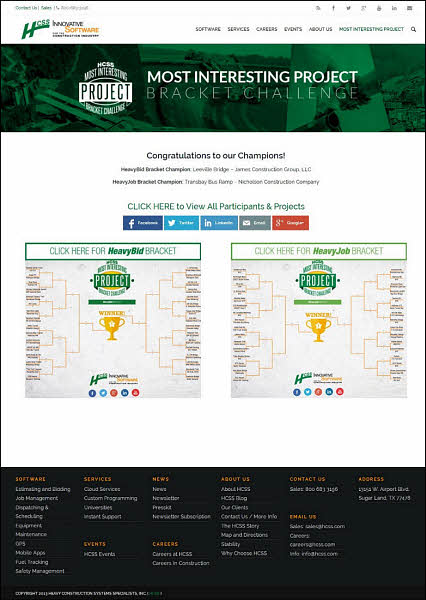
Click here to see the full version of this creative sample
The team had the technology available, so they began with the bracket itself, he said, and built
a microsite to host it.
"We knew we could pull it off, but we really tested the limits of [the] system," Moss said, adding that a microsite was built to hold the brackets, submissions and voting.
"It was probably about a week's worth of sweating and cursing," Briscoe said.
Step #2. Launch and run the bracket with agility
"Once we launched the bracket itself, we actually almost crashed our website within the first hour because we had so many people coming to view it," Moss said.
Since this was the largest scale project the team had ever done, other issues arose from the sheer volume of projects coming in. The team had to quickly and nimbly deal with these to keep the contest running with limited noticeable hiccups.
For instance, since there were far more submissions than originally projected, the team had to come up with a quick solution, and then support it.
"We ended up with so much information that we built two brackets ... We have so many photos and different levels of content that we had to create for each one," Moss said.
He added that Briscoe and a team writer had to "pretty much re-write two different versions of all the project submissions ... so it would format correctly for all the different viewports — desktops, mobile, tablets."
Another issue was that the team noticed one construction company had hired a company outside of the U.S. to vote for them.
"We had some really strange things that happened. So we had construction companies that figured out how to hire Romanian people to vote for them ... we had to track down cheaters and stop those. We were monitoring the voting in real time," Briscoe said.
The team figured out this tactic using their analytics reporting, and tracked down suspicious votes via their IP address. This allowed them to determine if it was an outsourcing firm for voting or click-based voting fraud.
For the most part, companies promoted themselves honestly and earnestly.
"Some got really good at engaging their networks and voting, so it became a very popular competition," Briscoe said.
It was interesting to see the voting evolve throughout the rounds, Moss said, because "we started to see more voting action happen during the first few rounds because there [were] more people involved. But as the rounds kept getting a little more competitive, the actual voting numbers increased."
Voting ran through March and ended in April, and each round of the bracket was between four days to a week long, and would then roll into the next round after HCSS had notified the winners. Altogether, the contest spanned 29 days.
Step #3. Promote contest by helping customers promote themselves
As the competition progressed, the HCSS team's efforts started to center around interacting with customers and their projects.
"That's where Dan, Kara and the rest of our team helped to educate our customers on how to use social media and leverage their networks, and promote their individual product pages and then to go vote," Moss said.
Communication was key, he added, which was "one of the hard lessons we learned."
The team started promoting this contest in January, and used email "quite heavily for that," according to Moss.

Click here to see the full version of this creative sample
They began by sending out an email
announcing the Most Interesting Project Bracket Challenge and giving the details of entering. Later, another announced voting was
open for round one. Then, an email was sent out announcing each round.
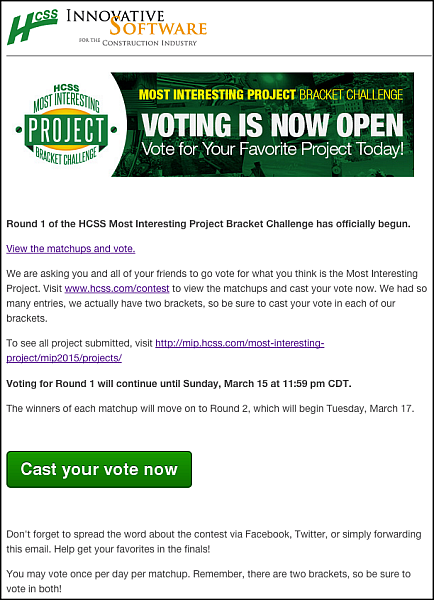
Click here to see the full version of this creative sample
Each email encouraged people to spread the word about the contest via social media and, throughout the competition, the team also used a lot of social media to promote the contest. However, they realized that it might be tricky to get construction companies to use social media to promote themselves.
"The construction companies are not very tech savvy on social media. These are a lot of 45 [to] 50 year old guys that came up driving bulldozers, and so Twitter is not something that's really savvy to them. They do have younger employees, and so we did a lot of education," Moss said.
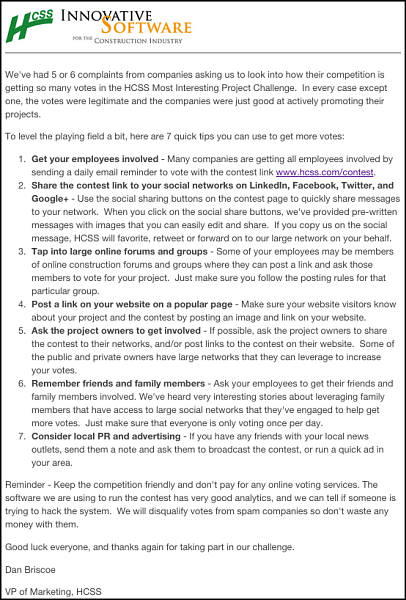
Click here to see the full version of this creative sample
The team sent out
an email that addressed the one case of voting fraud, and gave tips on how to legitimately increase votes, such as using
social media and more traditional methods.
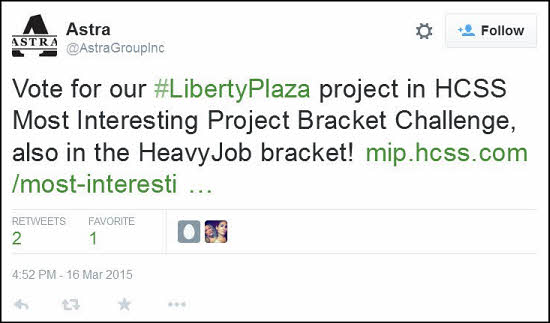
Click here to see the full version of this creative sample
"We used email to do that, but then we would get on and re-tweet and follow people, and so it did start to get a good social gathering. A lot of them would reach out to news agencies and things like that, [that] had bigger social networks. We would leverage social networks that way too," Moss said.
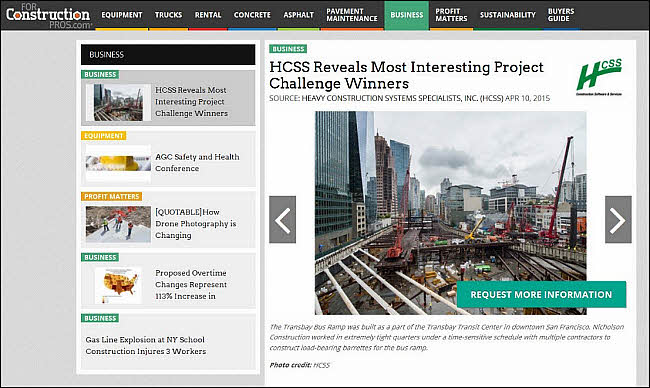
Click here to see the full version of this creative sample
HCSS had a lot of referral traffic as the challenge got picked up by
blogs and even Louisville's Fox News station.
"But as an overall interesting social step, we don't have much social interaction with our customers on a day-to-day basis," Moss said, but he added that during the 29 days of the campaign, "We had 10,400 visits from a social networks alone. Which was about 432% increase over our normal social traffic."
Involve employees
HCSS did a referral system to leverage its own employees, who "have such deep ties to our customers," Moss said.
"They were emailing them hourly to try to help them out and give them tips. If we didn't hear it directly back [from] the customers, we were hearing it through the grapevine through our employees," he said.
The small employee incentive program was that the employee whose clients submitted a project were eligible to win a prize as well, according to Briscoe.
"What happened is they were engaging with the customers all the time. 'Hey, you guys behind? Get moving. Here are some things you need to try,'" Briscoe said, adding that there were probably 30 to 40 employees who had customers with entries.
RESULTS
"Skyler [Moss] and our graphic designer and others put together this infographic … about the overall contest. Our executive team is now using this all over the place. We didn't mean for it to be external facing, [but] they're showing it everywhere," Briscoe said.
Customers are already excited about next year's competition, he added, necessitating that the Most Interesting Project Challenge become an annual campaign.
One of the biggest benefits, Moss said, of building the website around the project is that customers use this content for their own businesses.
"It actually turns out … that our customers use [the contest website to] sell to their customers or potential customers. It actually helped them win projects," Moss said.
During the course of this contest, the 120 projects submitted by 89 companies were split into two brackets and received a total of 295,000 votes. The overall results were:
- 125 countries participating in voting
- 3,585 cities in the U.S. participated in voting
- 134,000 Web sessions
- 3.47 pages viewed per session
- 96,000 new users
- 465,000 total page views
- 219,600 unique page views
"By highlighting these interesting projects, that also shows that it's not just the guys working on the road that you're driving through the congestion, wondering when they are ever going to be done. There's some really cool projects that these companies have done," MacDonald said.
HCSS will be speaking on this campaign at MarketingSherpa Summit 2016, held February 22-24 in Las Vegas.
This case study has also been selected as one of five finalists for the MarketingSherpa Award — Reader's Choice Campaign.
Keep reading MarketingSherpa newsletters to see case studies from other finalists and then, in a few weeks, we'll ask you to vote for your favorite on the MarketingSherpa blog.Creative Samples
- Contest website
- Announcement email
- Round one email
- Tips email
- Company tweet
- Blog mention
Sources
HCSS SnapApp — HCSS's vendor
Related Resources
MarketingSherpa Summit 2016 — At the Bellagio in Las Vegas, February 22-24
Inbound Marketing: Pinterest-based strategy leads to 77% new site trafficYouTube Engagement: Niche holiday celebration results in over 110,000 video views















